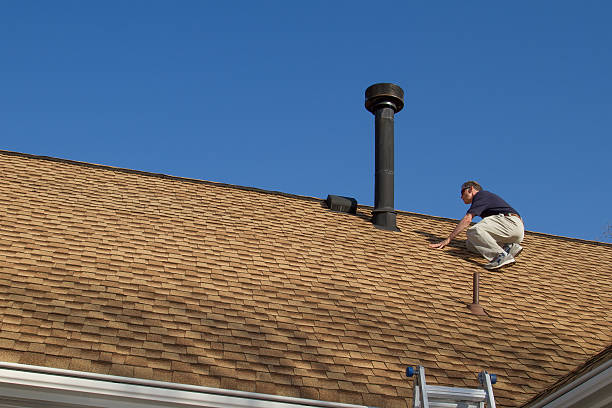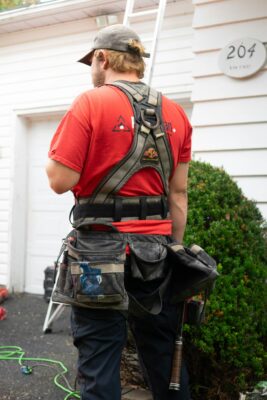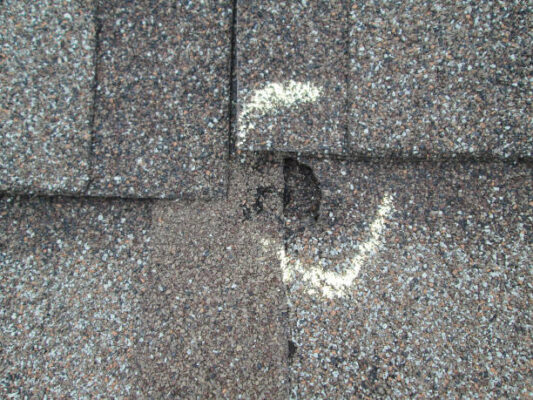To quickly check your own roof in Austin, start by glancing at your gutters, downspouts, and look for bruises on your roof’s surface. If the gutters and downspouts are bent and bruised, chances are that the roof material is also in bad shape.
If the roof’s surface has cracks, bruises, and missing granules on the ridge caps, hips, and valley areas, it’ll be less ready to fight off a hailstorm.
Austin’s weather can go from sunshine to baseball-sized hail in less than an hour. The metro area and nearby suburbs from Mueller and Windsor Park to Travis Heights and out to Round Rock, Cedar Park, and Pflugerville have seen damaging hail in recent years.
In 2024, there were dozens of hail reports inside a 10-mile radius of downtown Austin, and violent storms in 2025 produced golf-ball to baseball-size hail that left thousands without power and homes with exterior damage.
If you live in Austin, a little proactive checking before storm season can save you time, money, and headaches when adjusters and contractors start knocking on doors.
Let’s see a practical, safety-first guide you can use to evaluate your roof from the ground and with minimal climbing. We’ll also tip you on when to call a pro, how to record what you find for insurance, and local neighborhood tips that Austinites have been following for a while.
1) Follow safety measures before checking your own roof in Austin
Do not go on a steep roof unless you have experience, a harness, and someone spotting you. Many inspection steps are safer from the ground, attic, or a ladder at the eaves. Professional roofers and insurance adjusters use harnesses and fall protection; homeowners who try to “race the storm” are the ones who end up in the ER.
If you’re unsure, call a local roofer for a free roof inspection since many Austin roofers offer photo inspections after severe weather. Follow all the safety measures available if you’re doing a deeper roof inspection on your own home.
2) How to check your own roof from the ground?
Walk around your house or property and look for:
- Broken glass, dings on patio furniture, dented gutters or downspouts. These are easy visual clues that hail was strong enough to damage roofing materials and leave debris. Insurance adjusters often look for these signs as confirmation.
- Granule buildup in gutters. After hail, asphalt shingles often shed granules. If your gutters are full of black/brown grit, the roof likely lost protective material, which has fallen into the gutters.
- Dents on A/C units, metal flashing, vents, or skylight frames. Metal components dent more obviously than shingles and can be a clear clue of roof strikes.
If you spot any of these, record everything with time-stamped photos. Take wide shots that show the house location and close-ups of damage. These photos will help when you file an insurance claim.
3) How to check your roof with binoculars and ladders?
From the ground and a stable ladder at the eaves:
- Scan the roof surface with binoculars by looking for circular bruises, missing granules, cracked or split shingles, or spots where asphalt looks exposed. Hail bruises can look like shallow dents or darker “soft” areas.
- Check the ridge caps, hips, and the valley areas where hail and wind do the most damage.
- Check flashing around chimneys, vents, and roof-to-wall intersections for dents or looseness. Damaged flashing often causes leaks later, even if the shingles look OK.
If anything looks strange, mark it with a numbered sticky note from the ground so you (or a contractor) can reference the same spots during a professional inspection.
Why check these items: Because if they’re worn, cracked, dented, or damaged, it’s a sign that these structures are weak and at risk of completely degrading. It can also tell that the actual roof might be in a similar situation.
4) How to check the attic before the next Austin hailstorm hits?
Go into your attic (when safe and dry) with a flashlight:
- Look for light coming through (pinholes or larger), water stains, or damp insulation. These are early signs that a roof is compromised, even if it’s looking fine outside.
- Check the roof decking for soft spots where hail may have cracked plywood. A brief, careful poking with a screwdriver at the attic side (not the exterior) can reveal weakened material. If you see signs, note them down and call a pro.
5) How to get local information about hailstorms in Austin, TX
Local reports tell you the storm footprint. After the intense May 2025 storm, Austinites in Windsor Park, Mueller, and along MoPac posted videos and photos showing large hail and broken windows; those are useful signals that your insurance company might see a wave of claims from the same ZIP codes (e.g., several reports clustered in 78731 and nearby areas).
Asking around the communities, local roofing companies, and neighborhoods can help you understand which areas were hardest hit and whether contractors are already busy.
6) What to photograph when inspecting your own roof in Austin, TX
When documenting:
- Wide shot of the entire house showing context (street sign, tree, etc.).
- Close-ups of damaged gutters, vents, A/C, and any shingle bruising.
- Interior ceiling stains or attic issues.
- Damaged personal property (cars, furniture) if hail hit them too.
Time-stamp and back up photos to cloud storage.
Call your insurer promptly. The Texas Department of Insurance tells homeowners to record damage and contact carriers quickly to start a claim. Keep all receipts for temporary fixes (tarping, tarps, emergency repairs).
7) How to get free inspections in Austin, TX, after a hailstorm
After big storms, many contractors roll through neighborhoods offering “free roof inspections.” Many homeowners in Austin talk about mixed experiences: some contractors are legitimate and helpful, others pressure homeowners into unnecessary replacements.
Here are a few tips on what to ask Austin roofing contractors:
- Ask for local references.
- Verify their insurance and roofing license (ask for policy numbers).
- Get three written estimates when possible, and compare the scope, not just price.
- If the contractor is working with your insurer, confirm if they’ll coordinate directly with the adjuster and whether they offer a written warranty.
8) Should I repair or replace my roof after an Austin hailstorm?
If the damage was big and structural, replacement might be the best choice. But if the damage was just cosmetic, then repairing should save some bucks. Licensed adjusters and roof consultants use protocols (e.g., HAAG guidelines) to determine whether impacts are cosmetic or structural. These protocols also help to know whether a repair will restore the manufacturer’s warranty and whether a replacement is more cost-efficient.
Random isolated granule loss might lead to a repair, but distributed bruising across slopes, damaged ridge caps, and bent metal often push the decision toward replacement. If you suspect big structural damage, ask your roofer for a forensic sample or a written damage report.
9) When to call my Austin insurer and a roofer?
- Immediately: document and call your insurer for next steps.
- Within 24–72 hours: contact local, reputable roofers and schedule inspections; after big events, contractors book fast in Austin neighborhoods like North Loop and Travis Heights. Many roofers will meet adjusters on site, which speeds claims.
Final DIY roof checklist before the next Austin hailstorm
- Walk around the house and take photos of gutters, A/C, and siding.
- Use binoculars to see from the ground; ladder check at eaves only if safe.
- Inspect the attic for roof leaks or light passing through holes.
- Save photos to the cloud, call the insurer, and schedule a professional roof inspection.
- Vet contractors: license, insurance, references, and a written estimate.
Austin’s storm patterns call for homeowners to get ready and prepared. Whether you’re in central neighborhoods like Mueller and Travis Heights or in suburbs like Round Rock and Cedar Park. A timely, documented inspection (even basic DIY checks from the ground) gives you leverage with maintenance, insurers, and contractors, and peace of mind when the skies darken.





